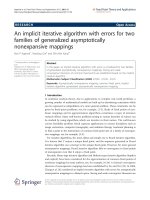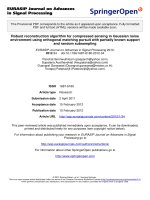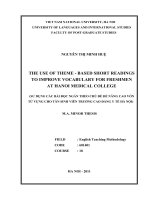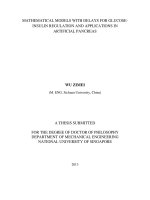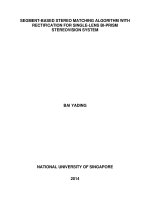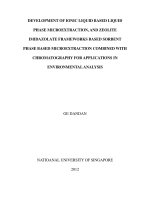Segment based stereo matching algorithm with rectification for single lens bi prism stereovision system
Bạn đang xem bản rút gọn của tài liệu. Xem và tải ngay bản đầy đủ của tài liệu tại đây (3.02 MB, 152 trang )
SEGMENT-BASED STEREO MATCHING ALGORITHM WITH
RECTIFICATION FOR SINGLE-LENS BI-PRISM
STEREOVISION SYSTEM
BAI YADING
NATIONAL UNIVERSITY OF SINGAPORE
2014
SEGMENT-BASED STEREO MATCHING ALGORITHM WITH
RECTIFICATION FOR SINGLE-LENS BI-PRISM
STEREOVISION SYSTEM
BAI YADING
(M.Sc., NATIONAL UNIVERSITY OF SINGAPORE)
A THESIS SUBMITTED
FOR THE DEGREE OF DOCTOR OF PHILOSOPHY
DEPARTMENT OF MECHANICAL ENGINEERING
NATIONAL UNIVERSITY OF SINGAPORE
2014
DECLARATION
DECLARATION
I hereby declare that the thesis
is
my
original
work
and it has been written by
me
in
its
entirety. I have duly acknowledged all the sources
of
information which have been used
in
the
thesis.
This thesis has also not been submitted for
any
degree
in
any university previously.
Bai Yading
19 August 2014
I
ACKNOWLEDGMENTS
II
ACKNOWLEDGMENTS
I would like to express the deepest appreciation to Associate Professor LIM KAH BIN, the
supervisor of my Ph.D. study, for giving me such an interesting and fruitful project to improve
and demonstrate my ability, and for his continuous supervision and valuable foresight and insight.
My gratitude also goes to Dr. Yong Xiao and Dr. Meijun Zhao, for their excellent early
contribution on single-lens bi-prism stereovision system:
I would like to thank Mrs. Ooi, Ms. Tshin, Miss Hamidah and all the staff in Control and
Mechatronics Laboratory of the Mechanical Engineering Department, for their kind support;
I consider it as an honor to work with WeiLoon Kee, Qing Wang, Jiayun Wu, Beibei Qian and
other colleagues and friends in Control and Mechatronics Laboratory;
I owe my gratitude to my parents who give me great help and constant love through out all my
student life.
TABLE OF CONTENTS
III
TABLE OF CONTENTS
Contents
DECLARATION I
ACKNOWLEDGMENTS II
TABLE OF CONTENTS III
SUMMARY VI
LIST OF SYMBLES VII
LIST OF TABLES IX
LIST OF FIGURES X
Chapter 1 Introduction 1
1.1Stereovision 1
1.1.1 Stereo-correspondence 1
1.1.2 Rectification 4
1.1.3 Correspondence search algorithm 5
1.2 Motivation 5
1.3 Organization of the thesis 6
Chapter 2: Literature Review 8
2.1 Epipolar geometry 8
2.2 Stereo rectification 10
2.3 Stereo matching algorithm 13
TABLE OF CONTENTS
IV
2.3.1 Global methods 14
2.3.2 Local methods 19
2.4 Image segmentation 21
2.4.1 Self-organizing map segmentation 22
2.4.2 Mean shift segmentation 24
2.4.3 Dense disparity feature 27
2.4.4 Image segmentation using level sets and active contour 27
2.5 Single-lens stereovision system 28
2.6 Summary 33
Chapter 3 Rectification of Single-lens Bi-prism Stereovision System 34
3.1 Background of stereovision rectification 36
3.1.1 Pinhole- camera model 36
3.1.2 Introduction of rectification using epipolar constraint 38
3.2 Ray-sketching approach to calculate the extrinsic parameters 41
3.2.1 Formation of virtual cameras 42
3.2.2 Determination of the extrinsic parameter using the ray-sketching method 44
3.3 Rectification algorithm 50
3.4 Experimental results 54
3.5 Summary 58
Chapter 4 Segment-based Stereo Matching Algorithm Using Belief Propagation 59
TABLE OF CONTENTS
V
4.1 Rectified image pair 61
4.2 Image segmentation 61
4.3 Disparity initialization using aggregation method 67
4.4 Disparity plane fitting 73
4.5 Refinement of the disparity plane 75
4.5.1 Refining disparity plane by outlier filtering 76
4.5.2 Refining disparity plane by merging connected segments with same disparity 80
4.6 Formulation of energy function 82
4.7 Belief propagation method 86
4.8 Depth recovery using disparity map 91
4.9 Summary 93
Chapter 5 Experiment Results and Analysis 94
5.1 Experiment setup 94
5.2 Experimental results and analysis 96
5.2.1 Experimental results based on the image pairs taken from Middlebury database 97
5.2.2 Experimental results using image pairs captured by single-lens bi-prism system 103
5.3 Summary 118
Chapter 6 Conclusion 120
List of Publications 126
Bibliography 127
SUMMARY
VI
SUMMARY
This thesis aims to develop a novel segment-based stereo-matching algorithm for 3-D depth
recovery. The algorithm is to further improve the stereo correspondence results to achieve the
said purpose. A novel segment-based stereo matching algorithm to extract the disparity
information from the captured stereo image pair is proposed. A local method to obtain an initial
disparity map is first employed and a segmentation algorithm (self-organizing map algorithm) is
then applied to segment an image into regions of homogenous colors at the same time.
Subsequently a plane fitting process is used to assign each segment a disparity plane. Finally, we
create and optimize an energy function to refine the disparity values. To simplify the stereo
correspondence search process, a rectification algorithm is developed. It involves the
computation of the transformation matrix to transform the stereo image pair into the rectified
stereo image pair. The algorithm developed is then tested on images captured by a single-lens bi-
prism stereovision system developed by our research group. The results are compared with those
determined by existing methods. To further demonstrate the effectiveness of our algorithm,
additional rectified image pairs are used in our experimental study chosen from available
standard database.
LIST OF SYMBLES
VII
LIST OF SYMBLES
World coordinate system (
,,
ww w
XYZ
)
Camera coordinate system (
,,
cc c
XYZ
)
Disparity of the corresponding points located in left and right images
d
Depth of object in world coordinate system
z
Baseline, the distance between two camera optical centers:
λ
Effective real camera focal length
f
Effective virtual camera focal length
'
f
Center of left image plane
(, )
l ol ol
cx y
Center of right image plane
(, )
r ro ro
cx y
Rotation matrix
R
Translation vector
T
Intrinsic parameters
int
M
Extrinsic parameters
ext
M
Fundamental matrix
F
Perspective projection matrix
p
P
LIST OF SYMBLES
VIII
Refractive index of the bi-prism glass
n
Epipole in the left image
l
e
Epipole in the right image
r
e
Matching cost of the stereo correspondence at point (
,xy
) with disparity
d
(,, )cxyd
Point in world coordinate system
(,,)
w
P XYZ
Point in the left image
(, )
lll
pxy
Point in the right image
(, )
rrr
pxy
Corner angle of the bi-prism
µ
LIST OF TABLES
IX
LIST OF TABLES
Table 4.1 Performance of proposed initial disparity acquisition algorithm…………………….76
Table 5.1 Performance of different algorithms……………………………………………… 112
Table 5.2 Recovered depth value of the pixels chosen from “Robot Fighter” image…………125
Table 5.3 Parameters used in experiments of stereo image pair “robot fighter”………………125
Table 5.4 Performance of proposed algorithm with and without image rectification…………127
Table 5.5 Experimental results of stereo correspondence searching by different algorithms…130
LIST OF FIGURES
X
LIST OF FIGURES
Figure 1.1 Searching of stereo correspondence and disparity. 2
Figure 1.2 Stereo image pair of the same scene captured by two cameras. 3
Figure 1.3 Rectification of a stereo pair. 4
Figure 2.1 Graph of epipolar geometry. 8
Figure 2.2 Configuration of rectified image planes. 11
Figure 2.3 Image structure after segmentation. 16
Figure 2.4 A randomly generated color palette. 24
Figure 2.5 Sketch map of mean shift 25
Figure 2.6 A single-lens stereovision system using a glass plate. 29
Figure 2.7 A single-lens stereovision system using three mirrors. 30
Figure 2.8 A single-lens stereovision system using two mirrors. 31
Figure 2.9 Single-lens stereovision system using prism. 32
Figure 3.1 Single-lens Bi-prism stereovision system. 35
Figure 3.2 Pinhole camera model. 37
Figure 3.3 Epipolar geometry of two views. 39
Figure 3.4 Image pair before and after rectification. 40
Figure 3.5 Formation of left and right virtual cameras 42
Figure 3.6 Relationship between left virtual camera and real camera 44
Figure 3.7 Sketch map of rectification algorithm. 51
Figure 3.8 “Book and card” image. 55
Figure 3.9 “Three objects” image a) left and right image; b) rectified left and right image 56
Figure 3.10 “Medicine” image a) left and right image; b) rectified left and right image 57
LIST OF FIGURES
XI
Figure 4.1 Procedure of our segment-based stereo matching algorithm. 60
Figure 4.2 Process of the color palette updating. 62
Figure 4.3 Segmentation results of Tsukuba: 65
Figure 4.4 Segmentation results of Art: 65
Figure 4.5 Segmentation result of Computer:. 66
Figure 4.6 Aggregation windows 69
Figure 4.7 a) Reference image (Computer/Middlebury(2005)); b) initial disparity map. 71
Figure 4.8 a) Reference image (Arts/Middlebury(2005)); b) initial disparity map. 71
Figure 4.9 Flow chart of refinement of the disparity plane by Outlier filtering. 79
Figure 4.10 Structure of the segmented image. 82
Figure 4.11Belief propagation Optimization. 87
Figure 4.12 Experimental results of Arts. 90
Figure 5.1 Single-lens bi-prism stereovision system. 95
Figure 5.2 Experimental results of Tsukuba 97
Figure 5.3 Experimental results of Venus 98
Figure 5.4 Experimental results of Teddy 98
Figure 5.5 Experimental results of Cones 99
Figure 5.6 Experimental results of image “Books”. 102
Figure 5.7 Result of Image pair 1 captured by single-lens bi-prism system:. 104
Figure 5.8 Result of Image pair 2 captured by single-lens bi-prism system: 105
Figure 5.9 Result of Image pair 3 captured by single-lens bi-prism system: 106
Figure 5.10 Result of Image pair 4 captured by single-lens bi-prism system:. 107
Figure 5.11 Result of Image pair 5 captured by single-lens bi-prism system: 108
LIST OF FIGURES
XII
Figure 5.12 Result of Image pair 6 captured by single-lens bi-prism system: 109
Figure 5.13 “Robot Fighter” image with 8 pixels chosen for the experiment. 112
Figure 5.14 Stereo image pair “Robot and Cup”. 114
Figure 6.1 Idea and non-ideal setups of single-lens stereovision system. 124
Figure 6.2 Schematic diagram of system setup using three single-lens stereovision system. 125
Chapter 1 Introduction
1
Chapter 1 Introduction
1.1Stereovision
Stereovision is one of the most extensively researched areas in computer vision. It is important in
3-dimensional scene analysis, depth recovery, object recognition, etc. In stereovision, two or
more images of the same scene are captured. Relevant information is then extracted and used to
obtain the depth of the objects of interest in the scene. A complete depth map of the scene is
obtained when the depths of all the pixels in the whole image are determined.
1.1.1 Stereo-correspondence
The basic problem in stereovision is searching the stereo correspondence which consists of
determining the corresponding point of a point in one image (usually called the left image) in the
other image (usually called the right image). Searching of the corresponding points in the two
images of the same scene is important as they are essential in the determination of depth of
objects in the scene. Figure 1.1 shows schematically a setup of a stereovision system.
In Figure 1.1,
P
is a point in the scene, the coordinates of which is
(,,)PXYZ
with respect to
the pre-determined world coordinate system
( ,, )
w ww w
OXYZ
.The optical center of the left and
right cameras are
( ,, )
L LL L
OXYZ
and
( ,, )
R RR R
OXYZ
, respectively.
λ
, which is known as base-
line distance, is the distance between
L
O
and
R
O
. It is bisected by
w
O
, note that the X-axes of
w
O
L
O
and
R
O
are aligned, and their Z-axes are all pointing in the same direction.
w
Z
is the
depth that the stereovision system is trying to recover.
Chapter 1 Introduction
2
Figure 1.1 Searching of stereo correspondence and disparity.
The left (
,
ll
xy
) and right (
,
rr
xy
) image planes are the images of the scene captured by the left
and right cameras, respectively. They are co-planar in Figure 1.1.
(, )
lll
pxy
and
(, )
rrr
pxy
are
the image points of
P
captured by the two said respective cameras. The two cameras are
assumed to have the same focal length
f
.
With this setup, the depth of the point
P
is given by
w
lr
ff
ZZ
xx d
λλ
= = =
−
(1.1)
where
d
is known as the disparity.
Chapter 1 Introduction
3
In Equation (1.1),
f
is the property of the camera,
λ
is the geometrical parameter. Thus, it is
clear that the depth is highly dependent on the disparity
d
:
lr
dxx= −
(1.2)
In the determination of
d
,
l
x
and
r
x
must be the x-coordinates of the same point in the scene, but
might appear at different locations in the two images. In stereovision,
(, )
lll
pxy
and
(, )
rrr
pxy
are known as correspondence points.
To illustrate this point, Figure 1.2 shows the two images of the same scene captured by two
cameras.
(, )
lll
Px y
and
(, )
rrr
Px y
are stereo correspondence points , whereas
'
l
P
and
'
r
P
are not.
Figure 1.2 Stereo image pair of the same scene captured by two cameras.
Chapter 1 Introduction
4
1.1.2 Rectification
The two image planes in Figure 1.1 are coplanar (in Figure 1.3 the planes
'
1
π
and
'
2
π
). It is a
special and very convenient system setup in stereovision. In practice the two image planes in a
stereovision system are usually not co-planar. They are usually at an angle to each other as
shown in Figure 1.3 (planes
1
π
and
2
π
). According to the epipolar geometry (which will be
discussed in Section 2.1), if the two image planes are coplanar, the searching process of stereo
correspondence points will be significantly simplified to a one dimensional search instead of the
two dimensional search on the whole image.
Figure 1.3 Rectification of a stereo pair.
Chapter 1 Introduction
5
1.1.3 Correspondence search algorithm
In this thesis, I propose a segment-based stereo matching algorithm using the belief propagation
briefly described below.
In the proposed algorithm, a self-organization map segmentation method is employed to divide
the reference image (chose one of the image from the image pair as the reference image) into
segments. At the same time, it searches for stable points in the image using an initial disparity
estimation method. A plane fitting process using the stable points is then applied to assign each
single segment a disparity plane. A refinement of the disparity plane by filtering out outlier and
merging connected segments with the same disparity plane is applied.
After the refinement, an energy function is created to evaluate the matching cost which will be
optimized to aid in finding the best disparity map. A belief propagation method is used to
complete the optimization process. The whole process shall be presented in Chapter 4.
1.2 Motivation
As mentioned above, searching the stereo correspondence points is an important issue and at the
same time, a challenging one in stereovision. The accuracy of the results of this step affects, to a
large extent, the result of 3-D depth recovery through the evaluation of disparity (Equation (1.2)).
Admittedly there are many existing approaches in solving the problem of stereo correspondence
search. In our research group, methods such as the calibration approach [65] and the geometrical
approach [108] have been developed, to different degrees of success.
Chapter 1 Introduction
6
The main motivation of this thesis is to develop a novel approach to produce accurate results in
stereo correspondence search. This helps to further expand the applicability of stereovision in
areas that involve 3-D depth or scene recovery.
1.3 Organization of the thesis
In this thesis, new approaches and algorithms in stereovision are proposed to recover the depth of
a scene in 3-D space. The thesis is organized into six chapters.
Chapter 1 introduces a general stereovision setup and discusses the main issues that affect the
accuracy of 3-D depth recovery. The algorithm and approach that are employed are introduced.
A review on the theories and algorithms in stereovision is presented in Chapter 2. It includes
epipolar geometry, epipolar constrain, rectification of stereo image pair, stereo matching
algorithms, segmentation of color images and a single-lens stereovision systems.
The stereovision rectification algorithm proposed in this work is described in Chapter 3 which is
based on a single-lens stereovision system. A ray-sketching approach is proposed to obtain the
extrinsic parameters of the virtual cameras with respect to the real camera. The algorithm of
computing the rectification transformation matrix is then proposed to rectify the stereo image
pair captured using this system.
Chapter 4 presents a novel segment-based stereo matching algorithm using belief propagation
algorithm. It consists of the following processes: color image segmentation, initial disparity map
acquisition, plane fitting, disparity plane refinement and optimization of the energy function of
disparity.
Chapter 1 Introduction
7
Chapter 5 gives the experimental results, which include the image segmentation results, final
disparity map after applying the proposed algorithm. The discussion on the accuracy of the
experiment result and comparison of the experimental results with other methods are also
presented then in this chapter.
Last but not least, the conclusion and discussion on the future work are given in Chapter 6. A
comprehensive list of reference is given after Chapter 6.
Chapter 2: Literature Review
8
Chapter 2: Literature Review
This chapter introduces and reviews the relevant methods which are useful to handle the stereo
correspondence search (stereo matching) problems.
2.1 Epipolar geometry
Epipolar geometry is an important concept in stereovision research. It is commonly exploited to
facilitate the stereo correspondence search process. Epipolar geometry has been discussed by
Trucco and Verri [1] and is briefly presented below.
Figure 2.1 Graph of epipolar geometry.
Chapter 2: Literature Review
9
In epipolar geometry, there are two pinhole cameras whose projection centers are
l
O
and
r
O
respectively which are shown in Figure 2.1. The image planes
l
π
and
r
π
are their image planes
respectively. The focal lengths are denoted by
l
f
and
r
f
. Normally, each camera identities a 3-D
reference frame fixed on its projection center and the z-axis is aligned with the optical axis. The
vectors
[ ,, ]
T
l ll l
P XYZ=
and
[ ,, ]
T
r rr r
P XYZ=
refer to the same 3-D point
P
which is thought as
a vector in the left and right camera reference frames respectively. The vectors
[,,]
T
l lll
p xyz=
and
[,,]
T
r rrr
p xyz=
refer to the projections of
P
onto the left and right image plane
respectively and they are expressed in the corresponding reference frame shown in Figure 2.1.
The reference frames of the left and right camera are related by the extrinsic parameters:
•
R
, the rotation matrix;
•
rl
TOO= −
, the translation vector.
The two parameters above enable us to define a rigid transformation in 3-D space. The relation
between the vectors
l
P
and
r
P
is given by:
()
rl
P RP T= −
(2.1)
The points at which the line through the center of projections (
l
O
and
r
O
) intersects the image
planes in Figure 2.1 are called epipoles. They are denoted as
l
e
and
r
e
in Figure 2.1.
Chapter 2: Literature Review
10
We can obtain the relation between a point in 3-D space and its projections is described by
Equation (2.2) and (2.3) in vector form.
l
ll
l
f
pP
Z
=
(2.2)
r
rr
r
f
pP
Z
=
(2.3)
2.2 Stereo rectification
In the discussion on epipolar geometry, the two image planes are not coplanar. It is therefore
very inconvenient to determine the epipolar line. In the stereo correspondence search, a special
arrangement known as rectified configuration is used. In this configuration, the two image planes
are co-planar as shown in Figure 2.2 (
l
o
and
r
o
are the optical centers of the left and right
cameras, respectively). Given a point
P
in the real space, its projective point in left image plane
is
l
p
, then the stereo correspondence point of
l
p
on the right image plane (
r
p
in Figure 2.2)
must lie on the line which is a horizontal scan-line through
l
p
and extended to the right image
(epipolar line).
Chapter 2: Literature Review
11
Figure 2.2 Configuration of rectified image planes.
Stereo rectification has been applied in photogrammetry for many years. The techniques
originally were optical-based, but were later replaced by software methods that model the
geometry of optical projection. In [2] an approach has been proposed by using the knowledge of
known camera parameters. Similar techniques are demonstrated in [3]. The necessity of known
calibration parameters is one of the disadvantages of these methods. Projective rectification has
been introduced to overcome this disadvantage by using epipolar geometry with various
constraints. In [4], a method to find the best transformation that preserves orthogonality around
image centers has been given.
Recently, a stereo rectification method which takes geometric distortion into account and tries to
minimize the effects of re-sampling has been given in [5]. Seitz et al. [6] propose a simple and
efficient algorithm for generic two view stereo image rectification. Another available approach
in [7] considered only the special case of partially aligned cameras. All these methods compute


